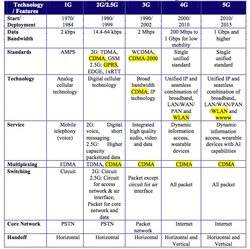Mobile Technology
Description
The first Generation
In 1970s, 1G phones were introduced. They were based on analogue system transmissions and were comparatively less heavy and expensive than the prior models. Some of the most popular among 1G system were advanced mobile phone system (AMPS), total access communication systems (TACS) and Nordic mobile telephone (NMT). The appearance of the 1G system caused the annual mobile phone market growth to rise from 30 to 50 percent and number of subscribers reached 20 million approximately by 1990.
The second generation
In the early 1990s, 2G phones using GSM technology were introduced. GSM uses digital modulation for improved voice quality but offers limited data services.
The need for mobile phones at this time was increasing and the 2G developers were working on improving it even more to enable phones provide better transmission quality and coverage. The 2G tech was then bettered to offer overall quality and also to offer other services to the users such as paging, faxing, messaging and voicemail. Additional services included WAP, HSCSD and MLS.
Later 2.5G was introduced, which uses the GPRS standard. GPRS brings the packet-switched capabilities to existing GSM networks. It allows users to send graphics-rich data as packets at a very fast speed. The importance for packet-switched increased with the rise of Internet and IP but since IP, too, has some weaknesses i.e. security and delay issues, the circuit-switched service was never left unused.
The third Generation
The 3G revolution brought us a new range of services. It allowed us to use audio, graphics and video applications. Furthermore, over 3G it was made possible to watch streaming video or to do video telephony.
One of the main objectives behind the developments of 3G was to have a single network standard instead of different types, adopted in Europe, U.S. and other regions. The 3G phones have some of the highest speed available to the mass market to date with speed up to 2Mpbs but only indoor or in stationary mode. Moving it with a high speed will drop the speed to 145 Kbps.
3G cellular services, known as UMTS appeared to sustain higher data rates and open the way to Internet style applications. The 3G technology supports both for packet and circuit switched data transmission. A single set of standards can be used worldwide with compatibility over a variety of mobile devices. With UMTS, global roaming was also made possible. 3G phones allow users to have access to Internet from any location while a new air interface called EDGE has already been developed. It specifically focuses to meet the bandwidth needs of 3G.
The fourth generation
Finally 4G is currently being developed with the aim of providing transmission rates up to 20Mbps while accommodating QoS. The technology is expected to appear by the year 2010. 4G will enable 3D virtual reality; imagine personal video avatars and the ability to feel as if you are present at an event when actually you are not. People, places and objects will be able to interact as the cyber and real-world blend.
4G applications are expected to include high-performance streaming of multimedia content, while it will also sort out the problems of limited bandwidth in 3G when people are on the move while using the technology, while also providing bandwidth in all locations.
The fifth generation
In 5G mobile IP, each cell phone is expected to have a permanent "home" IP address, along with a "care-of" address that represents its actual location. When a computer somewhere on the Internet needs to communicate with the cell phone, it first sends a packet to the phone's home address. A directory server on the home network forwards this to the care-of address via a tunnel, as in regular mobile IP. However, the directory server also sends a message to the computer informing it of the correct care-of address, so future packets can be sent directly. This should enable TCP sessions and HTTP downloads to be maintained as users move between different types of networks. Because of the many addresses and the multiple layers of subnetting, IPv6 is needed for this type of mobility. For instance, 128 bits (4 times more than current 32 bit IPv4 address) may be divided into four parts (I thru IV) for supporting different functions. The first 32-bit part (I) may be defined as the home address of a device while the second part (II) may be declared as the care-of address allowing communication between cell phones and personal computers. So once the communication path between cell and PC is established, care-of address will be used instead of home address thus using the second part of IPv6 address.
Enablers
- IPv6
- Merger and Acquisition
- Subsidizing policy
- Profitability in Web 2.0 business
Inhibitors
- Economic crisis
- Failure in Web 2.0 business
Paradigms
- Cell phone could access to home server and control the electric devices at home
- Electric money would be widely prevailed
Experts
- Nokia
- Sony Ericson
- NTT Docomo
- Apple
Resource
- http://en.wikipedia.org/wiki/History_of_mobile_phones
- http://www.buzzle.com/editorials/7-18-2004-56792.asp
- http://www.training-classes.com/programs/01/78/17803_2_5g_communication_systems.php
- http://www.scribd.com/doc/3324514/Introduction-to-Mobile-Telephone-Systems1G-2G-2-5G-and-3G-Wireless-Technologies-and-Services
- http://www.brighthub.com/mobile/emerging-platforms/articles/30965.aspx
